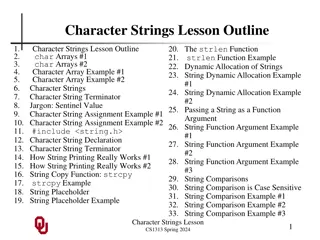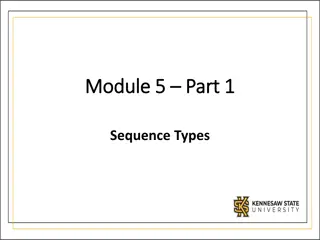
String Operations and Security Risks in Python Programming
Explore the use of eval() in Python, its potential security vulnerabilities, and the risks associated with interpreting user input as code. Discover how to manipulate strings, work with lists, and ensure code security in Python programming.
Download Presentation

Please find below an Image/Link to download the presentation.
The content on the website is provided AS IS for your information and personal use only. It may not be sold, licensed, or shared on other websites without obtaining consent from the author. If you encounter any issues during the download, it is possible that the publisher has removed the file from their server.
You are allowed to download the files provided on this website for personal or commercial use, subject to the condition that they are used lawfully. All files are the property of their respective owners.
The content on the website is provided AS IS for your information and personal use only. It may not be sold, licensed, or shared on other websites without obtaining consent from the author.
E N D
Presentation Transcript
CMSC201 Computer Science I for Majors Lecture 07 Strings and Lists Prof. Katherine Gibson www.umbc.edu Based on concepts from: http://mcsp.wartburg.edu/zelle/python/ppics2/code/
Last Class We Covered One-way, two-way, and multi-way decision structures if, if-else, and if-elif-else statements Control structures (review) Conditional operators (review) Boolean data type (review) Coding algorithms using decision structures 2 www.umbc.edu
Any Questions from Last Time? www.umbc.edu
Todays Objectives To discuss the usage of eval() and the potential security concerns To learn about lists and what they are used for To better understand the string data type Learn how they are represented Learn about and use some of their built-in functions 4 www.umbc.edu
About eval() www.umbc.edu
Previous Uses of eval() Remember our temperature converter? What does eval do? def main(): celsius = eval(input("What is the Celsius temperature? ")) fahrenheit = 9/5 * celsius + 32 print("The temperature is ", fahrenheit, " degrees Fahrenheit.") main() 6 www.umbc.edu
The Problem with eval() eval() interprets a string as code It lets a Python program run Python code within itself In our example, we use it to let Python decide what data type to store the input as If the user gives us an integer, store it as an int If the user gives us a decimal, store it as a float Using eval() is a security hole. 7 www.umbc.edu http://stackoverflow.com/questions/9383740/what-does-pythons-eval-do
The Problem with eval() But if the user gives us a malicious command to delete files or folders, it may also run that If you have os imported, and you ask for input using eval(input()), someone could type malicious code like in response os.system('rm hw1.py') This would delete your hw1.py file! 8 www.umbc.edu http://stackoverflow.com/questions/9383740/what-does-pythons-eval-do
What to Do Instead? Instead of using eval() to cast strings Use the exact type you want to cast to: int(input()) float(input()) 9 www.umbc.edu http://stackoverflow.com/questions/9383740/what-does-pythons-eval-do
Fixing the Temperature Converter Changed to a float cast def main(): celsius = float(input("What is the Celsius temperature? ")) fahrenheit = 9/5 * celsius + 32 print("The temperature is ", fahrenheit, " degrees Fahrenheit.") main() 10 www.umbc.edu
Introduction to Lists www.umbc.edu
Exercise: Average Three Numbers Read in three numbers and average them num1 = int(input("Please enter a number: ")) num2 = int(input("Please enter a number: ")) num3 = int(input("Please enter a number: ")) print((num1 + num2 + num3) / 3) Easy! But what if we want to do 100 numbers? Or 1000 numbers? Do we want to make 100 or 1000 variables? 12 www.umbc.edu
Using Lists Need an easy way to hold onto individual data items without needing to make lots of variables Making num1, num2, , num99, num100 is time-consuming and impractical Instead, we can use a list to hold our data A list is a data structure: something that holds multiple pieces of data in one structure 13 www.umbc.edu
Using Lists: Individual Variables We need an easy way to refer to each individual variable in our list Math uses subscripts (x1, x2, x3, etc.) Instructions use numbers ( Step 1: Combine ) Programming languages use a different syntax x[1], x[0], instructions[1], point[i] 14 www.umbc.edu
Numbering in Lists Lists don t start counting from 1 They start counting from 0! Lists with n elements are numbered from 0 to n-1 The list below has 5 elements, and is numbered from 0 to 4 0 1 2 3 4 15 www.umbc.edu
Properties of a List Heterogeneous (any data type!) Contiguous (all together in memory) Ordered (numbered from 0 to n-1) Have random (instant) access to any element Add elements using the append method They re mutable sequences of arbitrary objects 16 www.umbc.edu
List Syntax Use [] to assign initial values (initialization) myList = [1, 3, 5] words = ["Hello", "to", "you"] And to refer to individual elements of a list >>> print(words[0]) Hello >>> myList[0] = 2 17 www.umbc.edu
List Example: Grocery List You are getting ready to head to the grocery store to get some much needed food In order to organize your trip and to reduce the number of impulse buys, you decide to make a grocery list 18 www.umbc.edu
List Example: Grocery List Inputs: 3 items for grocery list Process: Store grocery list using list data structure Output: Grocery list 19 www.umbc.edu
Grocery List Code def main(): print("Welcome to the Grocery Manager 1.0") // initialize the value and the size of our list grocery_list = [None]*3 grocery_list[0] = input("Please enter your first item: ") grocery_list[1] = input("Please enter your second item: ") grocery_list[2] = input("Please enter your third item: ") print(grocery_list[0]) print(grocery_list[1]) print(grocery_list[2]) main() 20 www.umbc.edu
Grocery List Demonstration Here s a demonstration of what the code is doing 0 1 2 milk eggs oil bash-4.1$ python groceries.py Please enter your first item: milk Please enter your second item: eggs Please enter your third item: oil milk eggs oil grocery_list[2] = input("Please enter ...: ") print(grocery_list[0]) print(grocery_list[1]) print(grocery_list[2]) grocery_list[0] = input("Please enter ...: ") grocery_list[1] = input("Please enter ...: ") 21 www.umbc.edu
List Example: Grocery List What would make this process easier? Loops! Instead of asking for each item individually, we could keep adding items to the list until we wanted to stop (or the list was full ) We will learn more about loops in the next couple of classes 22 www.umbc.edu
Strings www.umbc.edu
The String Data Type Text is represented in programs by the string data type A string is a sequence of characters enclosed within quotation marks (") or apostrophes (') Sometimes called double quotes or single quotes FUN FACT! The most common use of personal computers is word processing 24 www.umbc.edu
String Examples >>> str1 = "Hello" >>> str2 = 'spam' >>> print(str1, str2) Hello spam >>> type(str1) <class 'str'> >>> type(str2) <class 'str'> 25 www.umbc.edu
Getting Strings as Input Using input() automatically gets a string >>> firstName = input("Please enter your name: ") Please enter your name: Shakira >>> print("Hello", firstName) Hello Shakira >>> type(firstName) <class 'str'> >>> print(firstName, firstName) Shakira Shakira 26 www.umbc.edu
Accessing Individual Characters We can access the individual characters in a string through indexing The characters in a string are numbered starting from the left, beginning with 0 Does that remind you of anything? 27 www.umbc.edu
Syntax of Accessing Characters The general form is STRING[EXPR] Where STRING is the name of the string variable and EXPR determines which character is selected from the string 28 www.umbc.edu
Example String 2 3 4 H e l l o 0 1 5 6 B o b 7 8 >>> greet = "Hello Bob" >>> greet[0] 'H' >>> print(greet[0], greet[2], greet[4]) H l o >>> x = 8 >>> print(greet[x - 2]) B 29 www.umbc.edu
Example String 2 3 4 H e l l o 0 1 5 6 B o b 7 8 In a string of n characters, the last character is at position n-1 since we start counting with 0 Index from the right side using negative indexes >>> greet[-1] 'b' >>> greet[-3] 'B' 30 www.umbc.edu
Substrings and Slicing www.umbc.edu
Substrings Indexing only returns a single character from the entire string We can access a substring using a process called slicing Substring: a (sub)part of another string Slicing: we are slicing off a portion of the string 32 www.umbc.edu
Slicing Syntax The general form is STRING[START:END] START and END must both be integers The substring begins at index START The substring ends before index END The letter at index END is not included 33 www.umbc.edu
Slicing Examples 2 3 4 H e l l o 0 1 5 6 B o b 7 8 >>> greet[0:3] 'Hel' >>> greet[5:9] ' Bob' >>> greet[:5] 'Hello' >>> greet[1:] 'ello Bob' >>> greet[:] 'Hello Bob' 34 www.umbc.edu
Specifics of Slicing If START or END are missing, then the start or the end of the string are used instead The index of END must come after the index of START What would the substring greet[1:1] be? '' An empty string! 35 www.umbc.edu
More Slicing Examples 1 2 3 4 H e l l o 0 5 6 B o b 7 8 -9 -8 -7 -6 -5 -4 -3 -2 -1 >>> greet[2:-3] 'llo ' >>> greet[-6:-2] 'lo B' >>> greet[-6:6] 'lo ' >>> greet[-9:8] 'Hello Bo' 36 www.umbc.edu
Forming New Strings - Concatenation We can put two or more strings together to form a longer string Concatenation glues two strings together >>> "Peanut Butter" + "Jelly" 'Peanut ButterJelly' >>> "Peanut Butter" + " & " + "Jelly" 'Peanut Butter & Jelly' 37 www.umbc.edu
Forming New Strings - Repetition Concatenating the same string together multiple times can be done with repetition Which operator would you use for this? >>> animal = "dogs" >>> animal*3 'dogsdogsdogs' >>> animal*8 'dogsdogsdogsdogsdogsdogsdogsdogs' 38 www.umbc.edu
Practice: Spam and Eggs >>> "spam" + "eggs" 'spameggs' >>> "Spam" + "And" + "Eggs" 'SpamAndEggs' >>> 3 * "spam" 'spamspamspam' >>> "spam" * 5 'spamspamspamspamspam' >>> (3 * "spam") + ("eggs" * 5) 'spamspamspameggseggseggseggseggs' 39 www.umbc.edu
Length of a String To get the length of a string, use len() >>> title = "CMSC 201" >>> len(title) 8 >>> len("Help I'm trapped in here!") 24 Why would we need the length of a string? 40 www.umbc.edu
String Operators in Python Operator Meaning Concatenation Repetition Indexing Slicing Length + * STRING[#] STRING[#:#] len(STRING) for VAR in STRING Iteration We ll cover this next class, when we learn for loops! 41 www.umbc.edu
Just a Bit More on Strings Python has many, many ways to interact with strings, and we will cover them in detail soon For now, here are two very useful functions: s.lower() copy of s in all lowercase letters s.upper() copy of s in all uppercase letters Why would we need to use these? Remember, Python is case-sensitive! 42 www.umbc.edu
String Processing Examples www.umbc.edu
Example: Creating Usernames Our rules for creating a username: First initial, first 7 characters of last name (lowercase) # get user s first and last names first = input("Please enter your first name: ") last = input("Please enter your last name: ") # concatenate first initial with 7 chars of last name uname = first[0].lower() + last[:7].lower() print("Your username is: ", uname) Why is this 7? 44 www.umbc.edu
Example: Creating Usernames >>> first = input("Please enter your first name: ") Please enter your first name: Donna >>> last = input("Please enter your last name: ") Please enter your last name: Rostenkowski >>> uname = first[0] + last[:7] >>> print("Your username is: ", uname) Your username is DRostenk Usernames must be lowercase! >>> uname = first[0].lower() + last[:7].lower() >>> print("Your username is: ", uname) Your username is drostenk 45 www.umbc.edu
Example: Creating Usernames >>> first = input("Please enter your first name: ") Please enter your first name: Barack >>> last = input("Please enter your last name: ") Please enter your last name: Obama >>> uname = first[0].lower() + last[:7].lower() >>> print("Your username is: ", uname) Your username is bobama What would happen if we did last[7]? IndexError but why does last[:7] work? 46 www.umbc.edu
Example: Printing the Months Given an integer (from 1 to 12) print the three letter abbreviation for that month Start by storing all the names in one big string: months = "JanFebMarAprMayJunJulAugSepOctNovDec" Use the number of the month to get the right slice of the months string 47 www.umbc.edu
Example: Printing the Months Let s figure out the position for each month name: months = "JanFebMarAprMayJunJulAugSepOctNovDec" 0123456789 5 5 5 Month Jan Feb Mar Apr May Jun Num Pos 1 0 2 3 3 6 4 9 5 12 6 15 Month Jul Aug Sep Oct Nov Dec Num Pos 7 8 9 10 27 11 30 12 33 18 21 24 48 www.umbc.edu
Example: Printing the Months Month Jan Feb Mar Apr Notice a pattern? Num 1 2 3 4 Pos 0 3 6 9 To get the position, subtract 1 from the month s number and multiply by 3 pos = (num-1) * 3 Use it to get the month name from the string 49 www.umbc.edu
Example: Printing the Months def main(): months = "JanFebMarAprMayJunJulAugSepOctNovDec" n = int(input("Enter a month number (1-12): ")) # compute starting position of month n in months pos = (n-1) * 3 # grab the appropriate slice from months monthAbbrev = months[pos:pos+3] # print the result print ("The month abbreviation is", monthAbbrev) main() 50 www.umbc.edu






















